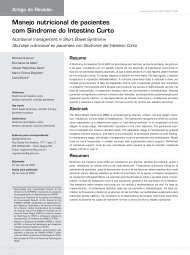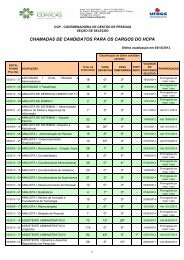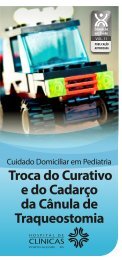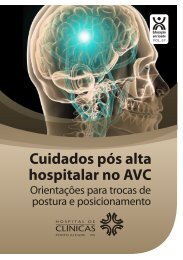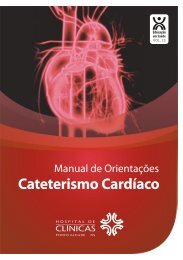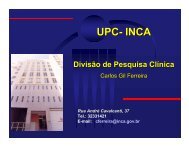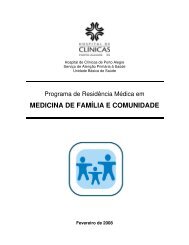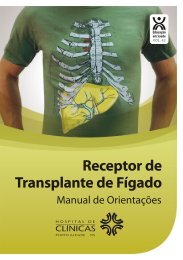Anais da 27º Semana CientÃfica - Hospital de ClÃnicas de Porto Alegre
Anais da 27º Semana CientÃfica - Hospital de ClÃnicas de Porto Alegre
Anais da 27º Semana CientÃfica - Hospital de ClÃnicas de Porto Alegre
You also want an ePaper? Increase the reach of your titles
YUMPU automatically turns print PDFs into web optimized ePapers that Google loves.
204<br />
Revista HCPA 2007; 27 (Supl.1)<br />
diagnosticados como malignos, continham histórico familiar presente, correspon<strong>de</strong>ndo tão somente 12,6%. As <strong>de</strong>mais 87,4%,<br />
apresentaram histórico familiar ausente. Por outro lado, <strong>de</strong>ntre os 381 pacientes, cujo resultado anátomo-patológico foi negativo,<br />
apenas 12,8% tinham histórico familiar e as <strong>de</strong>mais 87,2% não apresentavam antece<strong>de</strong>ntes familiares <strong>da</strong> doença. Os resultados<br />
obtidos encontram-se <strong>de</strong> acordo com a literatura. Consi<strong>de</strong>rando as limitações dos <strong>da</strong>dos, ressaltamos a necessi<strong>da</strong><strong>de</strong> <strong>de</strong> elaborar<br />
novos estudos bem como avaliar outras variáveis com o intuito <strong>de</strong> investigar os fatores <strong>de</strong> risco que prepon<strong>de</strong>ram no Câncer <strong>de</strong><br />
mama.<br />
Neurocirurgia<br />
WHITE FIBER DISSECTION TECHNIQUE AND ITS CORRELATION WITH DIFFUSION TRACTOGRAPHY OF<br />
MAGNETIC RESONANCE IMAGING: ITS RULE IN GLIOMA AND EPILEPSY SURGERY<br />
GUSTAVO RASSIER ISOLAN; LEONARDO VEDOLIN; LEANDRO INFANTINI DINI; MARINO MUXFELDT<br />
BIANCHIN, JOSÉ AUGUSTO BRAGATTI; FREDERICO SOARES FALCETTA; LUCAS REZNICEK; MARCO ANTÔNIO<br />
STEFANI.<br />
The fiber dissection technique is an anatomical method that involves peeling away the white matter tracts of the brain to display<br />
its three-dimensional anatomic organization. Early anatomists <strong>de</strong>monstrated many tracts and fasciculi of the brain using this<br />
technique.Diffusion tractography of magnetic resonance imaging (MRI), such as diffusion tensor tractography, on the other hand,<br />
allows us to visualize white matter tracts in vivo and to study white matter integrity quantitatively. The purpose of this study is<br />
compare the major tracts i<strong>de</strong>ntified in anatomical dissections and Diffusion tractography MRI. Material and methods: Fifhteen<br />
human ca<strong>da</strong>veric hemispheres were dissected by one of the authors in two different microsurgical laboratories (<strong>Hospital</strong><br />
Beneficência Portuguesa <strong>de</strong> São Paulo e University of Arkansas for Medical Sciences by using a modification of the method<br />
<strong>de</strong>scribed by Klingler. The correlation between this anatomy and Diffusion tractography MRI is done. Results: The major tracts<br />
and fasciculi are <strong>de</strong>scribed un<strong>de</strong>r the perspective of these two techniques. The authors discuss the current opinion regarding these<br />
techniques in intrinsic brain gliomas and epilepsy surgery. Conclusion: There is good correlation between both techniques.<br />
Clinical studies must be performed to <strong>de</strong>fine the real importance of the diffusion tractography MRI not only in planning the best<br />
corridor to approach tumors and lesions but also as a prognostic factor.<br />
THE IMPORTANCE OF THE PREOPERATIVE VENOUS ANATOMY STUDY IN PLANNING SKULL BASE<br />
APPROACHES TO TREAT CENTRAL NERVOUS SYSTEM TUMORS<br />
GUSTAVO RASSIER ISOLAN; GUSTAVO RASSIER ISOLAN M.D., PHD; LEONARDO VEDOLIN MD; MARCO<br />
ANTÔNIO STEFANI M.D., PHD., ÁPIO CLÁUDIO MARTINS ANTUNES M.D., PHD; FREDERICO FALCETTA M.S.;<br />
OMAR ANTÔNIO DOS SANTOS MD; RAFAEL MODKOVSKI MD; ANDRÉ CERUTTI FRANCISCATO MD; THIAGO<br />
TORRES DE ÁVILA MD<br />
The technical difficulty of using the skull base approaches and the likelihood of encountering venous complications <strong>de</strong>pend on the<br />
particular temporal venous anatomy. To reduce such potential risks, neurosurgeons must have a<strong>de</strong>quate knowledge of the<br />
variations in the anatomy of the temporal venous drainage system, particularly of the temporal bridging veins. Based on this, a<br />
<strong>de</strong>tailed preoperative study of the drainage pattern of the superficial venous system is paramount to <strong>de</strong>ci<strong>de</strong> the best approach to<br />
treat central nervous system tumors. The purpose of this study is present our current approach regarding this issue in our patients.<br />
A brief review of the superficial venous anatomy is presented and the imaging methods are discussed.<br />
THE PARADIGM OF SKULL BASE APPROACHES TO TREAT CENTRAL NERVOUS SYSTEM TUMORS: PART I: THE<br />
PETROSAL APPROACH<br />
GUSTAVO RASSIER ISOLAN M.D., PHD; MARCO ANTÔNIO STEFANI M.D., PHD., ÁPIO CLÁUDIO MARTINS<br />
ANTUNES M.D., PHD; FREDERICO FALCETTA M.S.; OMAR ANTÔNIO DOS SANTOS MD; RAFAEL MODKOVSKI<br />
MD; ANDRÉ CERUTTI FRANCISCATO MD; THIAGO TORRES DE ÁVILA MD<br />
Introduction: The petrosal approach provi<strong>de</strong>s excellent access to the petroclival region, the basilar trunk and apex, the<br />
anteromedial midbrain and the pons. To acess these regions the petrosal approach offers a number of advantages: (1) the<br />
surgeon’s operative distance to these regions is shorter than in retrosigmoid approaches. (2) There is minimal retraction of the<br />
cerebellum and temporal lobe. (3) The neural structures (seventh and eight nerve) are preserved. (4) The otologic structures<br />
(cochlea, labyrinth, semicircular canals ) are preserved. (5) Finally, the major venous sinuses (transverse and sigmoid), along with<br />
the vein of Labbe and other temporal and basal veins, are preserved. Material and Methods: The petrosal approach was performed<br />
in ten ca<strong>da</strong>veric specimens at the Microsurgical Laboratory (University of Arkansas for Medical Sciences). Two cases operated at<br />
the <strong>Hospital</strong> <strong>de</strong> Clínicas <strong>de</strong> <strong>Porto</strong> <strong>Alegre</strong> are presented to illustrate this approach. These cases were a huge tentorial and petrosal<br />
meningeomas, respectively. Results: the surgical steps patient position, craniotomy flap, cutting the tentorium and closure are<br />
<strong>de</strong>scribed, as well as the microsurgical anatomy. The tumor total resection was achieved in both patients without postoperative<br />
<strong>de</strong>ficits. Conclusion: The petrosal approach is inten<strong>de</strong>d to gain direct access to the petroclival and perimesencephalic regions<br />
while avoiding some of the complications associated with other approaches to this area.




